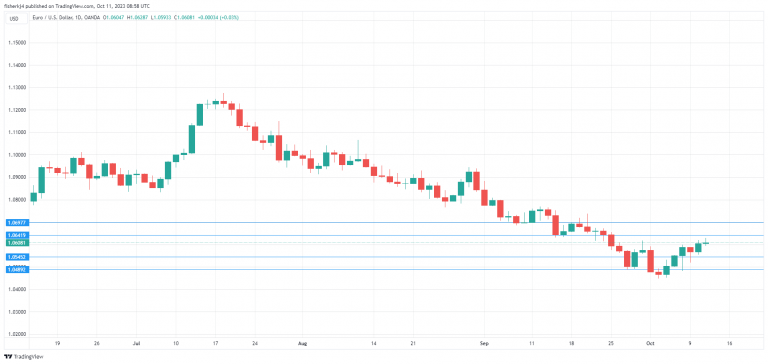-
German inflation declines.
-
Fed to release minutes of September meeting.
The euro continues to have an uneventful week. In the European session, EUR/USD is trading at 1.0613, up 0.08%.
German inflation falls to 4.5%
German inflation was confirmed at 4.5% y/y in September, sharply lower than the August reading of 6.1%. It was the lowest level since the Ukraine war started in February 2022. Energy prices fell sharply and food prices were also lower. The core rate eased to 4.6%, a one-year low and down from 5.5% in August. The inflation report is another sign that the ECB’s rate hikes are working and pushing inflation lower. Still, there is a long way to go, as inflation in Germany and the eurozone remains well above the ECB’s 2% target.
Germany’s economy has slowed down considerably. GDP was flat in the second quarter and the economy may have contracted in Q3. The German economy, once the pride of Europe, has been battered by high interest rates, weak consumer consumption and falling exports.
In the US, the data calendar has been very light, allowing the markets to focus on Fedspeak. A host of Fed members had a similar message in noting that the spike in US yields could act as a brake on the economy due to higher borrowing costs. This could push inflation lower without the Fed having to raise interest rates.
The Fed clearly is not going to announce that rates have peaked since another rate hike would lead to some loss in credibility. Fed Chair Powell and his colleagues seem to striving for transparency, and any divisions at the Fed over policy are a result of the uncertainty in the economic outlook. Market pricing indicates that the Fed is unlikely to raise rates this year – according to the CME Fedwatch Tool, the odds of a rate hike stand at 25%. Investors will be hoping for some insights from the FOMC minutes of the September meeting, in which the Fed held rates at a target range of 5.25%-5.50%.
EUR/USD technical
-
There is support at 1.0545 and 1.0489.
-
1.0641 and 1.0697 are the next resistance lines.
This article is for general information purposes only. It is not investment advice or a solution to buy or sell securities.
Opinions are the authors — not necessarily OANDA’s, its officers or directors. OANDA’s Terms of Use and Privacy Policy apply. Leveraged trading is high risk and not suitable for all. You could lose all of your deposited funds.
Recommended Content
Editors’ Picks
EUR/USD stays in positive territory above 1.0850 after US data

EUR/USD clings to modest daily gains above 1.0850 in the second half of the day on Friday. The improving risk mood makes it difficult for the US Dollar to hold its ground after PCE inflation data, helping the pair edge higher ahead of the weekend.
GBP/USD stabilizes above 1.2850 as risk mood improves

GBP/USD maintains recovery momentum and fluctuates above 1.2850 in the American session on Friday. The positive shift seen in risk mood doesn't allow the US Dollar to preserve its strength and supports the pair.
Gold rebounds above $2,380 as US yields stretch lower

Following a quiet European session, Gold gathers bullish momentum and trades decisively higher on the day above $2,380. The benchmark 10-year US Treasury bond yield loses more than 1% on the day after US PCE inflation data, fuelling XAU/USD's upside.
Avalanche price sets for a rally following retest of key support level

Avalanche (AVAX) price bounced off the $26.34 support level to trade at $27.95 as of Friday. Growing on-chain development activity indicates a potential bullish move in the coming days.
The election, Trump's Dollar policy, and the future of the Yen

After an assassination attempt on former President Donald Trump and drop out of President Biden, Kamala Harris has been endorsed as the Democratic candidate to compete against Trump in the upcoming November US presidential election.
